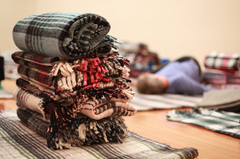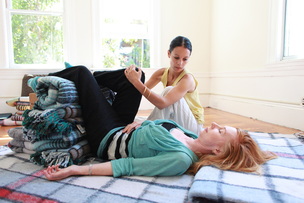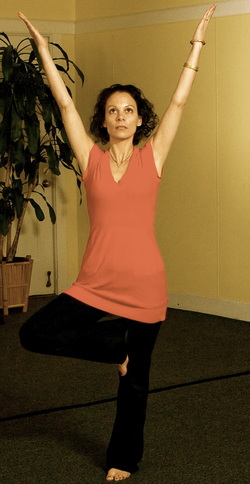 We all can understand that being inside the architecture of a Roman Cathedral has a particular internal effect, different from a log cabin! Or what about overlooking the Taj Mahal? Standing at the roots of a Redwood tree? Sitting fireside in an oceanside cottage? Architecture has an impact. What about the architecture of a yoga pose? What is the difference in effect between reclined, seated or standing poses? You can elevate the subtlety of your yoga practice if you take into consideration the effects of the architecture of the poses. Vāstu (the vedic science of arrangement, design and architecture) can be applied to the architecture of a home, business or place of worship, interior design, nature, and even the postures of the human body. Let's look at three of the main types of yoga poses - reclined, standing and seated - in terms of this tradition of noting the subtle effect of architecture. Reclined Poses - Horizontal Lines According to vāstu, a horizontal line relates to the following qualities:
In the body, a horizontal line can be seen in reclined or supine (supta in sanskrit) positions. An example of a horizontal line in design is a bed or a couch. Supine yoga poses are done for rest and relaxation, and are also recommended to new students, or when one is wanting to promote or recover from sleepiness (as in winding down at the end of the day), or when one is suffering / recovering from an ailment. This is one of the reasons why we begin yoga class with Shavasana - it is a time to rest / recover from your day, slough off any dis-ease from your day or week and to perhaps dip into yoga nidra (a yogic sleep state). Here is a list of some of the horizontal poses we practice commonly -
We also practice reclined poses because they are fully supported, and the combination of the support with the horizontal line's quality of relaxation makes for a deeper inner experience... yet it can come at a price - you might fall asleep :)) Both a beginner level practice and a deeper level practice may use a lot of reclined poses, but for different reasons. For a beginner, reclining is important because he / she may have more health problems and may be more exhausted from life or more lethargic. For a deeper student, the reclined poses offer a chance for groundedness and depth. Standing Poses - Vertical Lines According to vāstu, a vertical line (or a vertically diagonal line) relates to these qualities:
In the body, a vertical line can be seen in standing positions. An example of a vertical line in architecture is the Washington Monument or the peeks of a cathedral or temple Standing yoga poses are done for strength and vitality, and are also recommended for intermediate students, for students who need strength, vitality and stamina, or for students who have a mental need to stand or feel like they are "working" in a yoga class. Here is a list of some of the vertical poses you may have experienced -
Seated Poses - Horizontal/Vertical Hybrid Seated poses combine the qualities of horizontal and vertical lines because your legs are in a horizontal position and your torso is vertical... According to vāstu, a seated pose will cultivate
Seated Poses are the ideal position for a meditative experience or mediation practice for all of the above reasons. They are good for all levels of student, but especially useful for experienced students who are less in need of sleep and recovery (eg. supine poses like Shavasana) and less interested physical perfection or achievement (eg. standing poses like Warrior) and more inclined toward sitting in quiet alertness. Here is a list of some of the horizontal poses we practice commonly -
Seated poses offer an opportunity to sit in quiet absorption, but remain more alert and conscious than is possible when one is lying down in a horizontal position. It is possible for your whole spine to open in a seated meditation pose, in part because of the physical balance and stillness of the pose, but also because of the quietude of the mind... and when your mind lets go in deep states of quiet and peacefullness, your whole body can open up - remember the body is crystalized mind. What to do now...?In conclusion, a beautiful practice might include all three aspects of body-architecture - seated, reclined and standing poses. Or, you might dedicate a period of time - such as a month of your home practice - focusing on one type of pose, as we often do with our classes. Or, you might choose your practice daily, based on your physical and mental state. If you feel tired or ill, focus on reclined poses. If you feel you need to increase vitality or mental one-pointedness, do some standing poses. If you want to cultivate meditation, embark on a seated practice.
2 Comments
|
AuthorYoga Therapist, Ayurvedic Practitioner & Mama - these articles are to support your yoga practice with knowledge and inspiration. Categories
All
|
Kaya is the founder of SRY™ which is based in the full spectrum of the Vedic yoga tradition. She has been teaching therapeutic restorative yoga therapy since 2001. Kaya's work is healing, transformative, deeply rejuvenating and empowers her student and clients with wisdom and inner experience. Her trained in the full spectrum of the Vedic Tradition includes Yoga, Yoga Therapy, Prenatal Yoga, Ayurveda, Women's Health, Eastern Anatomy, Sanskrit, Vedic Astrology and Vedanta Philosophy. She collaborates with her husband Michael Manzella, a Vedic Astrologer, to serve yoga students and teachers who are inclined toward depth of inner experience and knowledge. MORE ON KAYA
 RSS Feed
RSS Feed